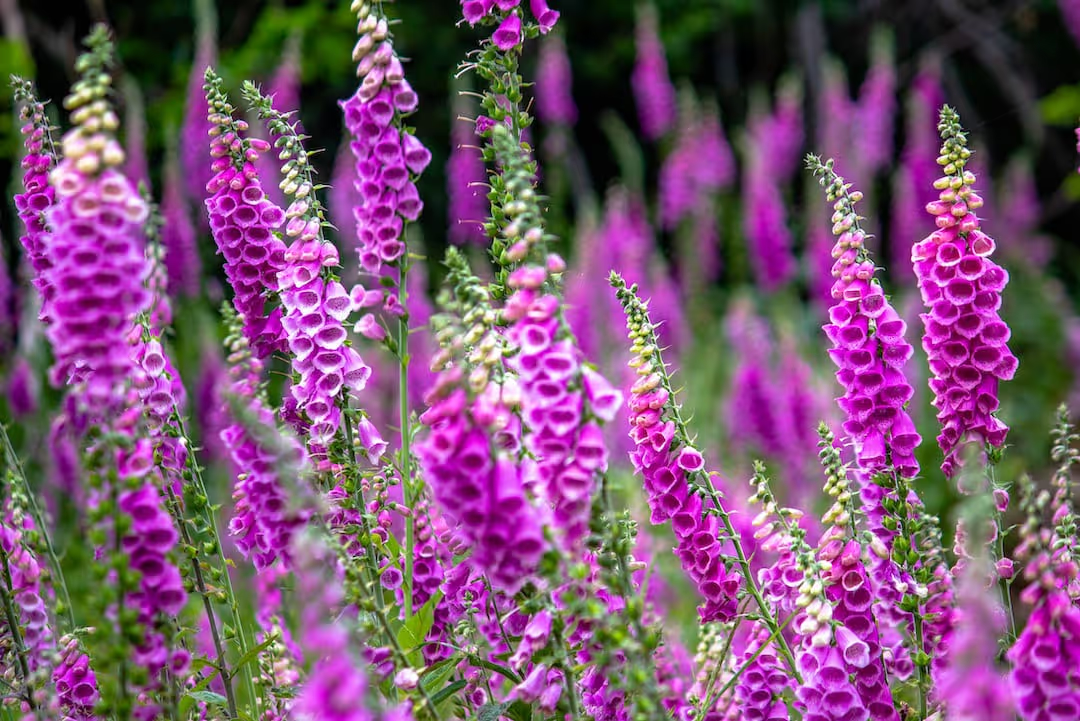Growing Foxglove for Elegant Blooms in Your Garden

Growing Foxglove
Growing foxglove brings vibrant spires and elegant charm to your garden. Sow foxglove seeds in partial shade and moist, well-drained soil for optimal blooms. By growing foxglove properly, you'll invite pollinators to feast and inject visual drama into your outdoor space—read on to make yours flourish.
Cheatsheet: Cultivating Majestic Foxglove Blooms
🌱 Site & Soil
- Light: Partial shade to full sun
- Soil: Moist, rich, well-draining (pH 5.5–6.5)
- Spacing: 12–18 in / 30–45 cm apart
🌼 Sowing & Planting
- Start seeds indoors 8–10 weeks before last frost or direct sow after frost
- Press seeds onto soil surface; do not cover
- Transplant after danger of frost passes (50–70°F / 10–21°C)
💧 Water & Feed
- Keep soil consistently moist, not soggy
- Mulch to retain moisture
- Feed with balanced fertilizer every 4 weeks
🍃 Care & Maintenance
- Stake tall stems to prevent flopping
- Deadhead to prolong bloom or save seeds
- Biennial habit: blooms year 2, self-seeds freely
⚠️ Safety & Benefits
- All parts contain digitalis—highly toxic if ingested
- 120+ pollinator species visit foxglove blooms
- Deer-resistant and supports local bees
🛠️ Tools & Products You'll Need
- Foxglove seeds or healthy nursery seedlings
- Organic compost
- Mulch
- Plant stakes/supports
- Watering can or hose with fine spray
- Gardening gloves (to avoid skin contact)
⏱️ Quick Stats
- Height: 2–5 ft / 60–150 cm
- Bloom time: Early to midsummer
- Time to flower: 12–14 months after sowing
- EstimatedCost: $5–$15
- PrepTime: 20 min
- PerformTime: 10 min/week
- TotalTime: 14 months
- Yield: Up to 100+ tall spires per patch
- Choose a partly shaded site with rich, moist, well-draining soil.
- Sow seeds indoors 8–10 weeks before last frost or direct sow post-frost; do not cover seeds.
- Transplant seedlings outdoors after frost (50–70°F / 10–21°C).
- Water to keep soil moist; mulch to conserve moisture.
- Feed monthly with a balanced fertilizer.
- Stake plants as they grow; deadhead spent blooms if seed is not desired.
- Wear gloves and wash hands after handling foxglove.
-
Growing Foxglove: site, soil, and light that set the stage
I give Digitalis a spot with morning sun and dappled afternoon shade in hot summers, and full sun in cool coastal areas. They want fertile, moist, well-drained soil with a pH near neutral, so I mix in compost and a bit of sharp grit for drainage.
Spacing matters for airflow and tall spires. I plant 12 to 18 inches apart, or 30 to 45 cm, and I avoid wet feet like a chef avoids a dull knife.
Understanding the biennial rhythm
Year one builds a low rosette, year two throws up towers of bells, then most plants bow out. I let a few stalks set seed so the patch renews itself like a staggered parade.
For uninterrupted color, I sow or buy new plants each year and mix in short-lived perennials like D. grandiflora and D. ferruginea to keep the backbone steady.
Sowing, timing, and transplants
Seeds need light to germinate, so I press them onto the surface and never cover. I keep them at 65 to 70 F, or 18 to 21 C, and evenly moist until tiny green freckles appear in 2 to 3 weeks.
In mild climates I start seed late summer for next year’s bloom, and in cold zones I start indoors 10 to 12 weeks before last frost. I transplant carefully at the 2 to 3 true leaf stage to avoid bruising the taproot.
First-year bloom from modern series
I lean on F1 lines for same-year color. The Dalmatian, Camelot, and Foxy series flower the first season if started early under steady light and warmth.
They’re dependable for show beds and sales benches, though I still tuck in classic heirlooms like ‘Excelsior’ for those cathedral spires that stop people mid-step.
Water, feed, and support
Foxgloves like consistent moisture, not soggy puddles. I water deeply once or twice a week in summer heat and use a 2 inch, or 5 cm, mulch to keep roots cool.
In spring I scratch in a balanced slow-release feed or a shovelful of compost. Tall stems sometimes need a discreet stake and a soft tie before a storm turns them into pick-up sticks.
Deadheading for encore blooms
After the main spike fades, I cut back to the basal leaves and leave a side shoot or two. That second flush isn’t as tall, but it keeps the border humming while the roses catch their breath.
Safety, toxicity, and placement
Every part of foxglove is poisonous due to cardiac glycosides, and ingestion can be fatal. I plant away from play areas and label pots in the nursery so no one mistakes a rosette for salad greens.
“All parts are highly poisonous; ingestion may prove fatal.” Royal Horticultural Society
Gloves on for cleanup and seed handling. Deer, rabbits, and voles tend to skip them, which is a rare gift in mixed borders.
Climate and overwintering
Digitalis purpurea laughs off winters in USDA Zones 4 to 9, with a light mulch of leaves to protect the rosette. In colder pockets I heel in container-grown plants near a wall and pull the mulch back in early spring.
Summer scorch can stall flowering in hot, humid regions. Afternoon shade and reliable watering keep spikes forming instead of sulking.
Pests and diseases I actually see
Slugs and snails chew rosettes, so I bait, hand-pick at dusk, and keep mulch thin near crowns. Aphids gather on buds after warm rains, and a quick hard spray or insecticidal soap clears them off.
Poor drainage invites crown rot, while tight spacing encourages powdery mildew and leaf spots. I space well, water at the base, and clean up spent leaves to break that cycle.
Design moves that make the spires sing
I run foxgloves as vertical exclamation points behind lady’s mantle, catmint, and low grasses, with white forms cooling hot borders like ice in a highball. Bronze fennel and soft ferns give the bells a moody backdrop that feels like a woodland stage.
For spring interest, plant them through tulips and alliums, then let the foxglove take over as bulbs fade. That handoff keeps the bed looking curated without constant fussing.
Growing Foxglove in containers
Use a 3 to 5 gallon, or 11 to 19 liter, pot with a gritty, peat-free mix and steady moisture. I stake early and tuck the pot into a border so the roots stay shaded and the tops shine.
Feed lightly every two weeks with liquid seaweed during active growth. Avoid tiny pots or they topple the first time a thunderhead rolls through.
Cut flowers that last
I cut when one-third of the bells are open and sear the base with hot water for 10 seconds to reduce sap bleed. Stems hold 5 to 7 days in a cool room at 65 F, or 18 C.
They play nicely with roses, larkspur, and grasses. I strip leaves that would sit below the water line to keep vases clean.
Top picks and smart buys
- First-year bloomers: Dalmatian Series, Camelot Series, Foxy Mix. Strong spikes for sales benches and container shows.
- Woodland elegance: ‘Pam’s Choice’ and ‘Sutton’s Apricot’. Tall, speckled throats with a vintage feel.
- Long-lived species: D. grandiflora and D. ferruginea. Short-lived perennials with amber to straw tones.
- Sterile hybrids for tidy beds: Illumination Series. Long season, minimal self-sowing, and Chelsea bragging rights.
- Shade-tolerant companions: hosta, heuchera, astrantia, and Japanese forest grass. They frame spires without fighting them.
Self-sowing without chaos
I let seed drop where I want a colony, then thin hard in spring to the best-spaced rosettes. If a color goes muddy, I pull those seedlings and reseed from saved or purchased stock.
To collect seed, I snip tan pods into a paper bag and label by cultivar and date. Seed keeps best in a cool, dry jar with a desiccant pack.
Common questions I get on Growing Foxglove
Will they bloom the first year from seed. Only if you grow first-year blooming series or start very early with ideal light and warmth.
Do they reseed true to type. Open-pollinated types reseed with some variation, and F1 hybrids rarely come true.
Are they invasive. In my coastal plots they self-sow modestly, but local behavior varies, so check regional guidance.
Are foxgloves good for pollinators. Bumblebees love the tubular bells and use the speckled throats as nectar guides.
My field notes that save time
Wind-exposed beds get stakes the day I see the spike, not after a storm turns the border into modern art. Afternoon shade keeps flower color richer in July heat at 95 F, or 35 C.
If rosettes sulk, it’s usually drainage. I fix the soil first, then feed, and the plants repay the favor with clean, tall stems.
Quick spec sheet for Growing Foxglove
- Type: Biennial or short-lived perennial
- Height: 2 to 6 ft, or 60 to 180 cm, depending on variety
- Light: Full sun in cool climates, partial shade in heat
- Soil: Moist, fertile, well-drained; pH 6.0 to 7.0
- Sow temp: 65 to 70 F, or 18 to 21 C
- Hardiness: USDA Zones 4 to 9
- Toxicity: High; handle and site with care
Troubleshooting at a glance
- Floppy spikes: Add morning sun, reduce nitrogen, and stake early.
- No blooms year two: Rosettes may have winter-killed; sow again in late summer to reset the cycle.
- Yellowing leaves: Check drainage, then feed lightly with balanced fertilizer.
- Powdery mildew: Increase spacing, water at soil line, and prune lower leaves for airflow.
Sources I trust and lean on
Royal Horticultural Society for cultivation, toxicity, and design notes. Missouri Botanical Garden Plant Finder for species data and cultural details.
North Carolina State Extension and UC IPM for pest and disease management. American Association of Poison Control Centers for safety guidance.
“Handle foxglove with care; the glycosides that made history in medicine also make this plant unsafe to ingest.” Missouri Botanical Garden and Poison Control guidance aligned
Frequently Asked Questions About Growing Foxglove
Where Should Foxgloves Be Planted for Ideal Results?
Plant foxgloves in partial shade to dappled sunlight, where they thrive best. Ensure soil is well-draining and nutrient-rich, slightly acidic to neutral (pH 6.0-7.0).
How Often Should Foxglove Plants Be Watered?
Water foxgloves consistently, keeping the soil evenly moist without waterlogging. Typically, watering once weekly to reach about 1 inch (2.5 cm) of moisture encourages healthy, vibrant blooms.
Do Foxgloves Require Fertilizing?
While heavy feeding isn't necessary, applying a balanced, slow-release organic fertilizer in early spring stimulates steady and healthy growth. Alternatively, amend soil annually with compost to maintain soil fertility naturally.
How Do You Encourage Foxgloves to Self-Seed?
Allow flower stalks to remain after blooming, giving foxgloves a chance to scatter seeds naturally as seed pods dry. Avoid heavy mulching around plants, enabling seeds to make direct contact with bare soil.
Are Foxgloves Hardy in Cold Winter Months?
Foxgloves tolerate cold climates well, surviving winter temperatures down to approximately 5°F (-15°C). Provide a light layer of mulch around the base of the plants for added winter protection, particularly in colder regions.
Is Foxglove Safe to Grow Near Pets or Children?
Foxgloves are toxic if ingested, especially the leaves, seeds, and flowers. Position the plants away from play areas and pet zones, and educate young children to avoid handling or consuming any parts of these plants.
How Tall Does a Mature Foxglove Plant Grow?
Foxgloves typically reach heights ranging from 3 to 5 feet (90 to 150 cm), depending on the variety and growing conditions. Plan the planting location accordingly to accommodate mature plant size and ensure ample space for growth.
Growing Foxglove brings an elegant drama to your beds that few flowers can match. These towers of color reward patience; just give them well-drained soil, good light, and a little space to breathe. Their blooms have an old-world charm but demand respect: remember, every part is toxic. Let foxglove anchor your borders or fill in spots between established perennials, and you’ll get a display that quietly steals the show. If you crave more edible or fragrant additions nearby, consider lemon balm or pineapple sage—both bring pollinators and a zip of herbal scent. Go slow, watch for self-sown seedlings, and enjoy the statuesque beauty that only growing foxglove can deliver. Every season, those spires remind you: some things are worth waiting for.
The Homesteader's Sustainable Guide to Foxglove Cultivation
Medicinal Self-Sufficiency
Foxglove (Digitalis purpurea) contains compounds historically used in folk medicines to support heart function. Modern pharmaceuticals utilize digitalis derivatives for heart medications. Careful: all parts are toxic if ingested improperly.
Natural Pest Control Benefits
- Attracts beneficial pollinators (bees, hummingbirds, ladybugs) reducing pesticide dependence.
- Deters deer and rabbits due to natural bitterness, protecting other crops grown nearby.
Sustainable Propagation Methods
Let foxglove flowers drop seed naturally each year or gather mature seed pods in autumn for storage. Store seeds cool (around 40°F/4°C) and dry for planting next spring, eliminating repeated seed purchase.
Integrating With Food Crops
Plant foxgloves around fruit-bearing shrubs or fruit trees. Increased pollinator presence raises fruit yields significantly—studies suggest bee visitation boosts fruit-set by up to 20%.
Composting Foxglove Waste
Flowers, leaves, and stems compost safely. Active composting (135-160°F/57-71°C) breaks down toxins effectively within 6 months, creating safe, rich organic fertilizer for vegetable beds.
Find out which plants will thrive in your garden!
Answer a few fun questions and get custom plant recommendations perfect for your space. Let’s grow something amazing together!

start your season





